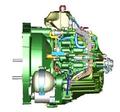The Alfa Romeo TCT gearbox operation
We managed to acquire the TCT gearbox as well as the engine and I suppose now is probably a good opportunity to go into the workings of the beast, trust me if you find a conventional gearbox a difficult concept to follow this is in a different league! I will try to simplify it as much as possible, so here goes; it's two gearboxes! Is that simple enough? By very clever engineering Alfa's engineers have managed to fit two gearboxes and two clutches in one housing. Starting at the clutches there are two conventional friction plates and there is a flywheel in between them, one clutch is for 1st, 3rd, 5th and reverse gears, while the other is for 2nd, 4th and 6th gear, so for ease of identification lets call one the odd clutch and the other the even clutch.
The odd clutch is nearest the engine and the even clutch is nearest the gearbox and as I said earlier there is a flywheel in between them. The odd clutch is normally engaged, so the clutch cover is pressing it against the flywheel. The even clutch is normally disengaged so it is free to rotate. The clutches power two concentric shafts, the inner longer shaft is driven by the odd clutch nearest the engine while the outer hollow short shaft is driven by the even clutch, so when the first gear is engaged and driven the inner shaft is powered while the outer shaft freewheels. The odd shaft protrudes from the even hollow outer shaft just enough to mount three gears on it, the odd gears as you may have guessed, while the larger hollow even shaft has the even gears mounted on it and they are nearest the engine. So we have fourth gear nearest the engine on the outer larger concentric shaft, then sixth gear and finally, we have second gear. The gears now step down onto the inner odd gear shaft and we start with third gear then fifth gear and finally on the outside of the gearbox we have first gear. So there is one short stumpy gearbox with a clutch and the even gears on it which is mounted on a hollow shaft and then running through the middle of that is another gearbox with a clutch at one end and gears at the other and a gap in the middle where the even gear gearbox sits.
OK, still following? so now we need to operate the clutches and as we have two clutches we need two operating systems. Now I deliberately slightly misinformed you in the earlier section just to make it a little bit clearer but running through the middle of the two concentric gear shafts is a clutch operating rod, so in fact, there are three concentric shafts; you see why I left it out as there are far too many concentric shafts! This operating rod goes right through the gearbox from one end to the other and at one end is the thrust bearing while at the other end is a clutch slave cylinder, this is controlled by the gearbox computer which engages or releases it by pulling on the rod that goes through the gearbox. The other clutch is also operated by the computer but this clutch is operated by a concentric slave cylinder, much the same as fitted to an Alfa 156/159. A concentric slave cylinder is a hydraulic ram that is hollow for those pesky concentric shafts to run through and this concentric slave operates the second clutch; who is now fed up with anything that is concentric? So let me just run through what is going on in the heart of this gearbox, in the very middle is a clutch operating rod, then there are two powered shafts and finally, there is the cylinder for the other clutch. So one clutch, the odd clutch is a pull-type clutch and the other is a push-type clutch.
So we have all this mass of rotating gears fixed to their various shafts spinning round, either driven by a clutch or freewheeling. These spinning gears mesh with two other sets of gears, one set on each layshaft and this is where the gear engagement takes place. It works much the same as the gearbox in the Alfa 159, which if you remember I explained in an earlier issue of the club magazine ;-) So to engage a gear, a hub that is attached to the layshaft is pushed over a gear that is freewheeling on the layshaft but is in mesh with the gear on the main concentric shaft, this then locks the main shaft to the layshaft and you are then in gear and the drive goes out to the differential pinion and drive shafts.
So we have the car in first gear driving along and second gear is engaged but the clutch is depressed so it is freewheeling. When it is time to change gear, first is disengaged by depressing its clutch while second gear is engaged by releasing the clutch. Now the engineers at Alfa do a really neat trick here, during the change over they slip one clutch against the other so torque is maintained to the wheels throughout the gear change, this makes the car a lot more stable while changing up through a corner. Now we are in second gear and the gearbox automatically engages third gear but depresses the clutch so that it freewheels ready to use, simple isn't it!
The whole of this process is driven by a hydraulic actuator and pump that is the power source and distribution system for operating the clutch slave cylinders, and the rods that physically change the gear and the actuator are managed by a microprocessor that interacts with the engine management system, ABS system via a computer network that operates from the body computer.

